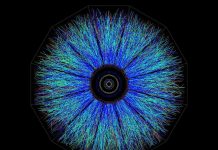
In a groundbreaking discovery that has left astrophysicists both amazed and puzzled, the Telescope Array experiment has detected the second-highest-energy cosmic ray ever observed.
This monumental find is second only to the highest-energy cosmic ray detected in 1991 by the University of Utah’s Fly’s Eye experiment, famously known as the Oh-My-God particle.
Cosmic rays are subatomic particles from outer space, carrying immense energy.
The Oh-My-God particle, when first observed, confounded scientists due to its extraordinarily high energy, which seemed impossible for any known source in our galaxy or even from distant galaxies to produce. Simply put, it defied the existing theories about cosmic rays.
Fast forward to May 27, 2021, and the Telescope Array, an experiment led by the University of Utah and the University of Tokyo, detected another extreme-energy cosmic ray, second only to the Oh-My-God particle in terms of energy.
This detection was made outside of Delta, Utah, where the Telescope Array covers a vast area of about 700 square kilometers (270 square miles) with 507 detector stations.
The cosmic ray triggered 23 detectors in the northwest region of the Telescope Array, spanning an area of 48 square kilometers (18.5 square miles). Intriguingly, the direction from which this cosmic ray came appeared to be from the Local Void, a vast, empty space near the Milky Way galaxy.
This discovery raises more questions than answers, as John Matthews, co-spokesperson at the Telescope Array and co-author of the study, points out.
Despite tracing the trajectory of these high-energy particles, their source remains a mystery, as no known high-energy object exists in that region of space.
Published in the journal Science, this international collaboration of researchers named the newly detected particle the Amaterasu particle, after the Japanese sun goddess.
The finding is significant as it confirms the reality of such ultra-high energy events in the cosmos.
These cosmic rays are not just high-energy particles; they are echoes of colossal celestial events, capable of stripping matter down to its subatomic components and propelling it through the universe at nearly the speed of light.
When these rays hit Earth’s atmosphere, they collide with molecules like oxygen and nitrogen, creating a cascade of billions of secondary particles that scatter to the surface. Detecting these requires a large array of detectors like those in the Telescope Array.
Interestingly, cosmic rays are generally affected by electromagnetic fields in space, making their paths zigzag and difficult to trace.
However, particles with energy levels like the Oh-My-God and Amaterasu particles plow through space relatively unaffected, indicating their origin from some of the most powerful cosmic events.
The energy of these particles is astounding.
The Amaterasu particle carried an energy of 2.4 x 10^20 electron volts (eV), equivalent to the kinetic energy of a brick falling on your toe from waist height.
To put this into perspective, this energy level is tens of millions of times higher than what the most powerful human-made particle accelerators can achieve.
Astrophysicists have a theoretical limit for the energy of cosmic rays known as the Greisen–Zatsepin–Kuzmin (GZK) cutoff. This limit is based on the maximum energy a proton can carry over long distances in space before losing energy due to interactions with the cosmic microwave background radiation.
The energy levels of both the Oh-My-God particle and the Amaterasu particle exceed this theoretical limit, deepening the mystery.
The Telescope Array, strategically located in Utah’s West Desert, is ideal for detecting such cosmic rays. Its high elevation and dry, dark conditions are perfect for observing the secondary particle showers resulting from cosmic ray impacts.
The array is currently undergoing an expansion, which will nearly quadruple its size, in hopes of capturing more such events and possibly unraveling the mysteries behind these enigmatic cosmic rays.



